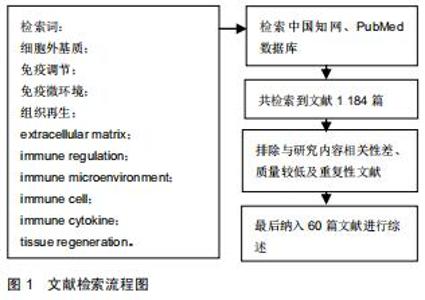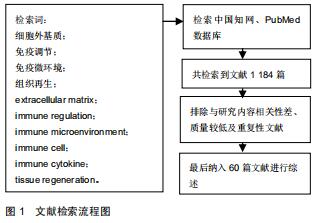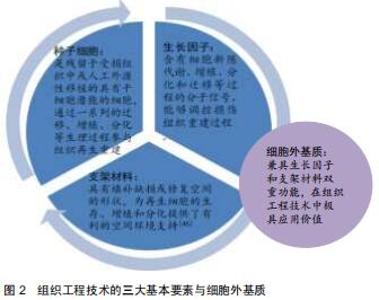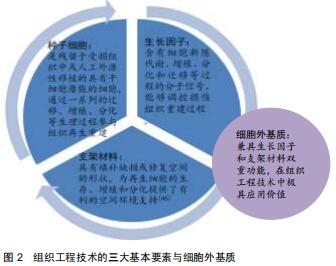Chinese Journal of Tissue Engineering Research ›› 2020, Vol. 24 ›› Issue (35): 5701-5707.doi: 10.3969/j.issn.2095-4344.2873
Previous Articles Next Articles
Immunomodulation of extracellular matrix and its role in tissue regeneration
Yang Wenxiao, Yang Ning, Liu Yao
Department of Children’s Stomatology, School of Stomatology, China Medical University, Liaoning Provincial Key Laboratory of Oral Diseases, Shenyang 110002, Liaoning Province, China
-
Received:2020-03-09Revised:2020-03-14Accepted:2020-04-15Online:2020-12-18Published:2020-10-19 -
Contact:Liu Yao, MD, Associate professor, Department of Children's Stomatology, School of Stomatology, China Medical University, Liaoning Provincial Key Laboratory of Oral Diseases, Shenyang 110002, Liaoning Province, China -
About author:Yang Wenxiao, Master candidate, Department of Children's Stomatology, School of Stomatology, China Medical University, Liaoning Provincial Key Laboratory of Oral Diseases, Shenyang 110002, Liaoning Province, China -
Supported by:the National Natural Science Foundation of China, No. 81600825; Shenyang High-Level Innovative Talent Project, No. RC190480
CLC Number:
Cite this article
Yang Wenxiao, Yang Ning, Liu Yao. Immunomodulation of extracellular matrix and its role in tissue regeneration[J]. Chinese Journal of Tissue Engineering Research, 2020, 24(35): 5701-5707.
share this article
|
[1] THEOCHARIS AD, SKANDALIS SS, GIALELI C, et al. Extracellular matrix structure. Adv Drug Deliv Rev. 2016;97:4-27.
[2] BONNANS C, CHOU J, WERB Z. Remodelling the extracellular matrix in development and disease. Nat Rev Mol Cell Biol. 2014; 15(12):786-801.
[3] SUN Z, GUO SS, FÄSSLER R. Integrin-mediated mechanotransduction. J Cell Biol. 2016;215(4):445-456.
[4] ZHU J, LUO BH, XIAO T, et al. Structure of a complete integrin ectodomain in a physiologic resting state and activation and deactivation by applied forces. Mol cell.2008;32(6):849-861.
[5] RAY SJ, FRANKI SN, PIERCE RH, et al. The collagen binding alpha1beta1 integrin VLA-1 regulates CD8 T cell-mediated immune protection against heterologous influenza infection. Immunity. 2004;20(2):167-179.
[6] DANGERFIELD J, LARBI KY, HUANG MT, et al. PECAM-1 (CD31) homophilic interaction up-regulates alpha6beta1 on transmigrated neutrophils in vivo and plays a functional role in the ability of alpha6 integrins to mediate leukocyte migration through the perivascular basement membrane. J Exp Med.2002;196(9): 1201-1211.
[7] CHOU J, CHAN MF, WERB Z. Metalloproteinases: A functional pathway for myeloid cells. Microbiol Spectr. 2016;4(2):10.
[8] RICARD-BLUM S. The collagen family. Cold Spring Harbor Perspect Biol.2011;3(1):a004978.
[9] JABŁOŃSKA-TRYPUĆ A, MATEJCZYK M, ROSOCHACKI S. Matrix metalloproteinases (MMPs), the main extracellular matrix (ECM) enzymes in collagen degradation, as a target for anticancer drugs.J Enzyme Inhib Med Chem.2016;31(sup1): 177-183.
[10] WEBSTER NL, CROWE SM. Matrix metalloproteinases, their production by monocytes and macrophages and their potential role in HIV-related diseases.J Leukoc Biol.2006;80(5):1052-1066.
[11] WANG Y, CHU Y, YUE B, et al. Adipose-derived mesenchymal stem cells promote osteosarcoma proliferation and metastasis by activating the STAT3 pathway. Oncotarget. 2017;8(14): 23803-23816.
[12] NABHA SM, DOSSANTOS EB, YAMAMOTO HA, et al. Bone marrow stromal cells enhance prostate cancer cell invasion through type I collagen in an MMP-12 dependent manner.Int J Cancer. 2008;122(11):2482-2490.
[13] KIM KH, BURKHART K, CHEN P, et al. Tissue inhibitor of metalloproteinase-1 deficiency amplifies acute lung injury in bleomycin-exposed mice.Am J Respir Cell Mol Biol.2005; 33(3): 271-279.
[14] SCHAEFER L, SCHAEFER RM. Proteoglycans: From structural compounds to signaling molecules.Cell Tissue Res.2010;339(1): 237-246.
[15] TIAN X, AZPURUA J, HINE C, et al. High-molecular-mass hyaluronan mediates the cancer resistance of the naked mole rat. Nature.2013;499(7458):346-349.
[16] LEE-SAYER SS, DONG Y, ARIF AA, et al. The where, when, how, and why of hyaluronan binding by immune cells.Front Immunol. 2015;6:150.
[17] TOLG C, MCCARTHY JB, YAZDANI A, et al. Hyaluronan and RHAMM in wound repair and the “cancerization” of stromal tissues. Biomed Res Int. 2014;2014:103923
[18] TEDER P, VANDIVIER RW, JIANG D, et al. Resolution of lung inflammation by CD44. Science. 2002;296(5565):155-158.
[19] EVANKO SP, CHAN CK, JOHNSON PY, et al. The biochemistry and immunohistochemistry of versican. Methods Cell Biol.2018; 143:261-279.
[20] WIGHT TN. Provisional matrix: A role for versican and hyaluronan. Matrix Biol. 2017;60-61:38-56.
[21] COULSON-THOMAS VJ, GESTEIRA TF, HASCALL V, et al. Umbilical cord mesenchymal stem cells suppress host rejection: The role of the glycocalyx. J Biol Chem. 2014;289(34):23465-23481.
[22] SARRAZIN S, LAMANNA WC, ESKO JD. Heparan sulfate proteoglycans. Cold Spring Harb Perspect Biol. 2011;3(7): a004952.
[23] WEBER M, HAUSCHILD R, SCHWARZ J, et al. Interstitial dendritic cell guidance by haptotactic chemokine gradients. Science.2013;339(6117):328-332.
[24] COLLINS LE, TROEBERG L. Heparan sulfate as a regulator of inflammation and immunity. J Leukoc Biol. 2019;105(1):81-92.
[25] HALLMANN R, HORN N, SELG M, et al. Expression and function of laminins in the embryonic and mature vasculature. Physiol Rev. 2005;85(3):979-1000.
[26] YADAV R, LARBI KY, YOUNG RE, et al. Migration of leukocytes through the vessel wall and beyond. Thromb Haemost. 2003; 90(4):598-606.
[27] WU C, IVARS F, ANDERSON P, et al. Endothelial basement membrane laminin alpha5 selectively inhibits T lymphocyte extravasation into the brain. Nat Med.2009;15(5):519-527.
[28] DUITMAN EH, ORINSKA Z, BULFONE-PAUS S. Mechanisms of cytokine secretion: A portfolio of distinct pathways allows flexibility in cytokine activity. Eur J Cell Biol. 2011;90(6-7):476-483.
[29] TRAVIS MA, SHEPPARD D. TGF-β activation and function in immunity. Annu Rev Immunol. 2014;32:51-82.
[30] JOHNSTON CJ, SMYTH DJ, DRESSER DW, et al. TGF-β in tolerance, development and regulation of immunity. Cell Immunol. 2016;299:14-22.
[31] ZILBERBERG L, TODOROVIC V, DABOVIC B, et al. Specificity of latent TGF-β binding protein (LTBP) incorporation into matrix: Role of fibrillins and fibronectin.J Cell Physiol. 2012;227(12): 3828-3836.
[32] WATERS JP, POBER JS, BRADLEY JR. Tumour necrosis factor in infectious disease. J Pathol. 2013;230(2):132-147.
[33] SEN A, PAINE SK, CHOWDHURY IH, et al. Assessment of gelatinase and tumor necrosis factor-α level in the vitreous and serum of patients with Eales disease: Role of inflammation- mediated angiogenesis in the pathogenesis of Eales disease. Retina.2011;31(7):1412-1420.
[34] LIMB GA, DANIELS JT, PLEASS R, et al. Differential expression of matrix metalloproteinases 2 and 9 by glial Müller cells: Response to soluble and extracellular matrix-bound tumor necrosis factor-alpha. Am J Pathol. 2002;160(5):1847-1855.
[35] DIGIROLAMO N, INDOH I, JACKSON N, et al. Human mast cell-derived gelatinase B (matrix metalloproteinase-9) is regulated by inflammatory cytokines: Role in cell migration. J Immunol. 2006; 177(4):2638-2650.
[36] SOKOL CL, LUSTER AD. The chemokine system in innate immunity. Cold Spring Harb Perspect Biol. 2015;7(5):a016303.
[37] SAVINO W, MENDES-DA-CRUZ DA, GOLBERT DC, et al. Laminin-mediated interactions in thymocyte migration and development. Front Immunol.2015;6:579.
[38] GAGGAR A, WEATHINGTON N. Bioactive extracellular matrix fragments in lung health and disease. J Clin Invest. 2016;126(9): 3176-3184.
[39] GORDON S. Pattern recognition receptors: Doubling up for the innate immune response. Cell. 2002;111(7):927-930.
[40] ABDULRODA M, FERNSTRAND AM, REDEGELD FA, et al. Thematrikine PGP as a potential biomarker in COPD. Am J Physiol Lung Cell Mol Physiol. 2015;308(11):L1095-L1101.
[41] MYDEL P, SHIPLEY JM, ADAIR-KIRK TL, et al. Neutrophil elastase cleaves laminin-332 (laminin-5) generating peptides that are chemotactic for neutrophils. J Biol Chem. 2008;283(15): 9513-9522.
[42] TADDESE S, WEISS AS, JAHREIS G, et al. In vitro degradation of human tropoelastin by MMP-12 and the generation of matrikines from domain 24. MatrixBiol. 2009;28(2):84-91.
[43] NANDADASA S, FOULCER S, APTE SS, et al. The multiple, complex roles of versican and its proteolytic turnover by ADAMTS proteases during embryogenesis. Matrix Biol. 2014;35:34-41. [44] HOPE C, FOULCER S, JAGODINSKY J, et al. Immunoregulatory roles of versican proteolysis in the myeloma microenvironment. Blood. 2016;128(5):680-685.
[45] 夏商,姜立铭,陈旭.组织工程技术应用于牙周膜再生研究进展[J].中国实用口腔科杂志,2016,9(9):557-560.
[46] ROSSO F, GIORDANO A, BARBARISI M, et al. From cell-ECM interactions to tissue engineering. J Cell Physiol. 2004;199(2): 174-180.
[47] DU J, CHEN H, QING L, et al. Biomimetic neural scaffolds: A crucial step towards optimal peripheral nerve regeneration. Biomater Sci. 2018;6(6):1299-1311.
[48] INGULLI E. Mechanism of cellular rejection in transplantation. Pediatr Nephrol. 2010;25(1):61-74.
[49] FISHMAN JM, LOWDELL MW, URBANI L, et al. Immunomodulatory effect of a decellularized skeletal muscle scaffold in a discordant xenotransplantation model.Proc Natl Acad Sci U S A. 2013;110(35):14360-14365.
[50] RANA D, ZREIQAT H, BENKIRANE-JESSEL N, et al. Development of decellularized scaffolds for stem cell-driven tissue engineering. J Tissue Eng Regen Med. 2015;11(4):942-965.
[51] CHENG CW, SOLORIO LD, ALSBERG E. Decellularized tissue and cell-derived extracellular matrices as scaffolds for orthopaedic tissue engineering. Biotechnol Adv. 2014;32(2): 462-484.
[52] WANG Y, BAO J, WU X, et al. Genipin crosslinking reduced the immunogenicity of xenogeneic decellularized porcine whole-liver matrices through regulation of immune cell proliferation and polarization. Sci Rep.2016;6:24779.
[53] TAJIMA A, PRADHAN I, GENG X, et al. Construction of thymus organoids from decellularized thymus scaffolds. Methods Mol Biol. 2019;1576:33-42.
[54] VELASCO MA, NARVÁEZ-TOVAR CA, GARZÓN-ALVARADO DA. Design, materials, and mechanobiology of biodegradable scaffolds for bone tissue engineering. Biomed Res Int.2015; 2015:729076.
[55] SKÓRA J, PUPKA A, DOROBISZ A, et al. Evaluation of the humoral and cellular immune responses after implantation of a PTFE vascular prosthesis. Postȩpy Hig Med Dosw(Online). 2012;66:469-474.
[56] NAJAR M, RAICEVIC G, FAYYAD-KAZAN H, et al. Mesenchymal stromal cells and immunomodulation: A gathering of regulatory immune cells. Cytotherapy. 2016;18(2):160-171.
[57] NA S, ZHANG H, HUANG F, et al. Regeneration of dental pulp/dentine complex with a three-dimensional and scaffold-free stem-cell sheet-derived pellet. J Tissue Eng Regen Med. 2013; 10(3):261-270.
[58] YANG Y, LIN H, SHEN H, et al. Mesenchymal stem cell-derived extracellular matrix enhances chondrogenic phenotype of and cartilage formation by encapsulated chondrocytes in vitro and in vivo. Acta Biomater. 2018;69:71-82.
[59] HOCH AI, MITTAL V, MITRA D, et al. Cell-secreted matrices perpetuate the bone-forming phenotype of differentiated mesenchymal stem cells. Biomaterials. 2015;74:178-187.
[60] GU Y, LI Z, HUANG J, et al. Application of marrow mesenchymal stem cell-derived extracellular matrix in peripheral nerve tissue engineering. J Tissue Eng Regen Med.2017;11(8):2250-2260. |
| [1] | Li Jiacheng, Liang Xuezhen, Liu Jinbao, Xu Bo, Li Gang. Differential mRNA expression profile and competitive endogenous RNA regulatory network in osteoarthritis [J]. Chinese Journal of Tissue Engineering Research, 2021, 25(8): 1212-1217. |
| [2] | Fan Quanbao, Luo Huina, Wang Bingyun, Chen Shengfeng, Cui Lianxu, Jiang Wenkang, Zhao Mingming, Wang Jingjing, Luo Dongzhang, Chen Zhisheng, Bai Yinshan, Liu Canying, Zhang Hui. Biological characteristics of canine adipose-derived mesenchymal stem cells cultured in hypoxia [J]. Chinese Journal of Tissue Engineering Research, 2021, 25(7): 1002-1007. |
| [3] | Zhang Mi, Wu Saixuan, Dong Ming, Lu Ying, Niu Weidong. Expression of interleukin-24 in a mouse model of periapical periodontitis [J]. Chinese Journal of Tissue Engineering Research, 2021, 25(5): 679-684. |
| [4] | Yang Yang, Yao Yu, Shen Xiaotian, Liu Jiajia, Xue Jianhua. Expression and significance of interleukin-21 in intervertebral disc degeneration [J]. Chinese Journal of Tissue Engineering Research, 2021, 25(5): 690-694. |
| [5] | Xie Yang, Zhang Shujiang, Liu Menglan, Luo Ying, Yang Yang, Li Zuoxiao. Mechanism by which rapamycin protects spinal cord neurons in experimental autoimmune encephalomyelitis mice [J]. Chinese Journal of Tissue Engineering Research, 2021, 25(5): 695-700. |
| [6] | Xie Yang, Lü Zhiyu, Zhang Shujiang, Long Ting, Li Zuoxiao. Effects of recombinant adeno-associated virus mediated nerve growth factor gene transfection on oligodendrocyte apoptosis and myelination in experimental autoimmune encephalomyelitis mice [J]. Chinese Journal of Tissue Engineering Research, 2021, 25(23): 3678-3683. |
| [7] | Wang Hao, Chen Mingxue, Li Junkang, Luo Xujiang, Peng Liqing, Li Huo, Huang Bo, Tian Guangzhao, Liu Shuyun, Sui Xiang, Huang Jingxiang, Guo Quanyi, Lu Xiaobo. Decellularized porcine skin matrix for tissue-engineered meniscus scaffold [J]. Chinese Journal of Tissue Engineering Research, 2021, 25(22): 3473-3478. |
| [8] | Li Shang, Huang Xiang, Chen Ming, Lei Mingxing, Cheng Shi, Zhang Licheng, Yin Pengbin, Tang Peifu. Semaphorin 3A is expected to be a new target for the repair of skeletal muscle injury [J]. Chinese Journal of Tissue Engineering Research, 2021, 25(20): 3232-3238. |
| [9] | Mu Yufeng, Wei Lina, Wu Yong, Shao Anliang, Chen Liang, Qu Shuxin, Xu Liming. Development and evaluation of alpha-galactosyl antigen-deficient rabbit model [J]. Chinese Journal of Tissue Engineering Research, 2021, 25(2): 281-285. |
| [10] | Zhang Hongqing, Xie Xufang, Wu Xiaomu. Effectiveness and clinical application limitations of stem cells in the treatment of multiple sclerosis and optic neuromyelitis spectrum diseases [J]. Chinese Journal of Tissue Engineering Research, 2021, 25(19): 3049-3056. |
| [11] | Li Xiangze, Bu Xianmin, Li Dongmei, Chi Yulei, Su Qiang, Jin Xintong, Zhao Jian, Zhang Gaotian, Wu Bin, Meng Chunyang . Stem cells, cytokines, hormones, neuropeptides and genes in traumatic brain trauma to promote fracture healing [J]. Chinese Journal of Tissue Engineering Research, 2021, 25(19): 3057-3063. |
| [12] | Shen Fu, Kuang Gaoyan, Yang Zhuo, Wen Meng, Zhu Kaimin, Yu Guizhi, Xu Wuji, Deng Bo . Immune infiltration mechanism of differential expression genes in rheumatoid arthritis and potential therapeutic prediction of Chinese herbs [J]. Chinese Journal of Tissue Engineering Research, 2021, 25(14): 2183-2191. |
| [13] | Mao Xin, Yu Limei, Wang Feng. Important role of mesenchymal stem cells in immune tolerance induction in heart transplantation [J]. Chinese Journal of Tissue Engineering Research, 2021, 25(13): 2070-2078. |
| [14] | Qian Nannan, Zhang Qian, Yang Rui, Ao Jun, Zhang Tao. Mesenchymal stem cells in the treatment of spinal cord injury: cell therapy and combination of new drugs and biomaterials [J]. Chinese Journal of Tissue Engineering Research, 2021, 25(13): 2114-2120. |
| [15] | Li Liqiang, Jiao Longxing, Zhang Wu, Yan Wentao, Li Jian, Li Minghao. Effect of immature dendritic cells derived from bone marrow on rejection of orthotopic liver transplantation in rats [J]. Chinese Journal of Tissue Engineering Research, 2021, 25(13): 2025-2029. |
| Viewed | ||||||
|
Full text |
|
|||||
|
Abstract |
|
|||||



